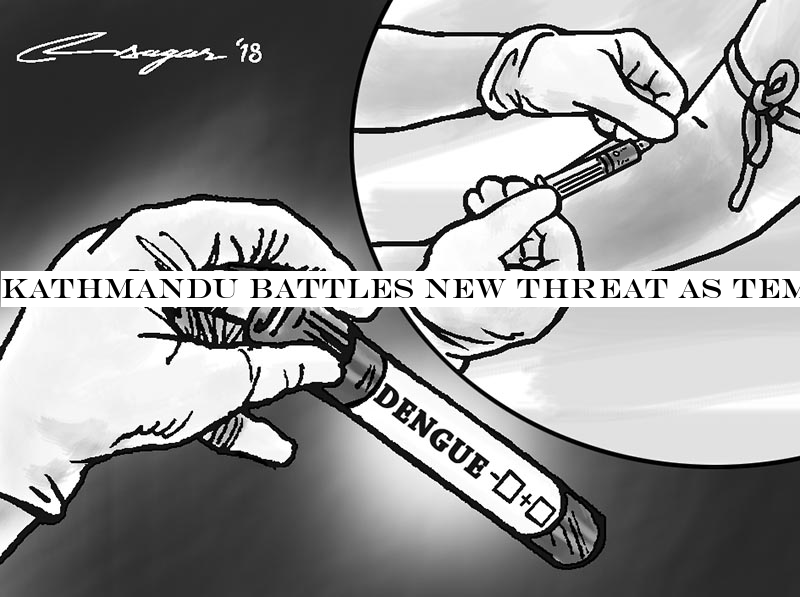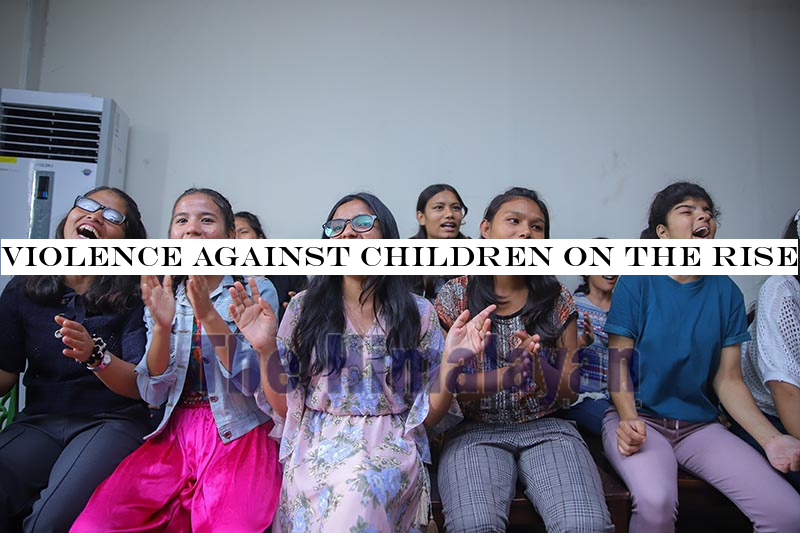Music
Trailers
DailyVideos
India
Pakistan
Afghanistan
Bangladesh
Srilanka
Nepal
Thailand
Iraq
Iran
Russia
Brazil
StockMarket
Business
CryptoCurrency
Technology
Startup
Trending Videos
Coupons
Football
Search
Download App in Playstore
Download App
Best Collections
Nepal
 Golmaal | (गोलमाल) Episode - 76 | एलिस र म्याकुरीको प्रान्कमा खुईली !! | 16 September 2019 VideoLink: https://trailer.ecroaker.com/component/search/?videoid=S9wh5eIhLoc
Golmaal | (गोलमाल) Episode - 76 | एलिस र म्याकुरीको प्रान्कमा खुईली !! | 16 September 2019 VideoLink: https://trailer.ecroaker.com/component/search/?videoid=S9wh5eIhLoc- Details
- Category: Nepal

KATHMANDU: For Prabina Maharjan, it started with a headache, which then turned into fever and body pain.
When she finally turned up at the Sukraraj Tropical and Infectious Disease Hospital a week ago, tests showed something odd for this high-elevation city: dengue fever, a scourge more associated with Nepal‘s low-lying tropics.
But as climate change brings hotter temperatures, disease threats are shifting & and this year Kathmandu, Nepal‘s capital in the Himalayan foothills, is seeing an unprecedented surge of dengue.
In just the first week of September, more than 1,000 cases of the fever were diagnosed at the citySukraraj Tropical and Infectious Disease Hospital, a quarter of them contracted in the Kathmandu area, said Anup Bastola, the hospitalchief tropical medicine consultant.
In previous years, the hospital mainly has seen cases of the painful and occasionally fatal disease in people coming from Nepal‘s southern lowlands, he said.
&But this year we saw many cases from the Kathmandu Valley itself,& he added.
In a city that has never faced such a large local outbreak, fear of dengue is so rife that people are flooding to hospitals for testing, even if they turn out to have a simple headache or seasonal flu, the doctor said.
&The flow of patient is so high that the staff are busy testing blood samples up until late in the night,& Bastola said.
Those in the testing lines included 39-year-old Maharjanmother and son, who also turned out to have caught the mosquito-carried illness, though weren&t hospitalised for a week as she was.
&We were astonished to be infected by a disease that is generally considered a disease of the Terai,& said Maharjan, referring to a southern tropical region of Nepal.
Like many, she is puzzled why the disease is now taking off in hilly Kathmandu, which lies at 1,400 metres (4,600 feet).
&There were mosquitoes in the valley in past years too, but we never heard about the outbreak of this disease in such a large scale,& Maharjan said.
MORE HEAT, LESS KNOWLEDGE
As climate change brings hotter conditions in many countries, health threats are rapidly changing, with many authorities underprepared, international public health officials warn.
According to data published by Nepal‘s disease control division, more than 250 cases of locally contracted dengue were detected in the Kathmandu Valley between mid-July and early September, two of them fatal.
Last year, the valley saw only six cases, according to the agencyfigures.
Meghnath Dhimal, chief research officer at the government&s Nepal Health Research Council, said rising temperatures associated with climate change are the major driver of the new threat.
&In Nepal, the first outbreak of this disease occurred in 2006, when only five districts were affected. But this year the disease was found in 56 out of 77 districts,& he said.
Warmer conditions help spread the disease both by making it easier for mosquitoes to reproduce, and by spurring the virus itself to replicate faster.
But &migration of infected mosquitoes and human cases from the tropical parts (of Nepal) plays a role in seeding the disease& in new areas, he said.
Because there is no vaccine or particular medicine to treat dengue, reducing the number of mosquitoes is the main way to reduce its spread, Dhimal said.
But Nepal‘s government, confronted with a fast-rising threat, so far has not put in place enough programs to do that, he said.
&As the highlands were rarely previously affected by dengue, people and government official are not well-prepared to prevent and control the disease& he said.
In most cases, efforts to battle the problem start &only after it has gained ground&, he said.
That means &the insects that are not eliminated this year will (lay eggs and) surge again next year after it starts getting to a favourable temperature,& Dhimal said.
Another obstacle in controlling the disease is simply the lack of awareness of many people about the emerging threat.
For example, residents may protect themselves against mosquito bites at night, but the dengue-carrying mosquito bites during the day, something few people in Kathmandu know, he said.
A study he led in 2012 found people in lowland Nepal were five times more likely than people in highland areas to understand dengue risks.
If highland Nepal is to successfully fight back against dengue, &awareness of people and control of the vector by effective government action and community mobilisation can be the only effective step&, Dhimal said.
The post Kathmandu battles new threat as temperatures rise: dengue fever appeared first on The Himalayan Times.
- Details
- Category: Nepal
Read more: Kathmandu battles new threat as temperatures rise: dengue fever
Write comment (94 Comments)Kathmandu, September 15
Frequent rainfall in the capital is likely to increase the number of dengue causing mosquitoes. High temperature accompanied by frequent rainfall has been providing favourable environment forthe mosquitoes to breed.
&The rainfall pattern and temperature provide favourable environment for mosquitoes to breed. Heavy rainfall would wash away eggs and larvae of the mosquito, but current pattern of rainfall is likely to increase dengue causing mosquitoes,& said Bibek Kumar Lal, director of Epidemiology and Disease Control Division.
Rainwater gets accumulated holes in trees, empty vessels and on the surface. The mosquitoes lay eggs and in favourable temperature these eggs develop into adult mosquitoes.
&As the climate of the capital is changing, number of dengue cases will rise,& said anofficial from Epidemiology and Disease Control Division.
As many as 1,170 dengue cases were reported inside Kathmandu valley till September 10. &Many of the patients are from Khusibo, Sano Bharyang and Balkhu,& said Anup Bastola, Spokesperson and Consultant Tropical Medicine Physician at Sukraraj Tropical and Infectious Disease Hospital, Teku.
Lalitpur and Bhaktapur have reported 35 and 33 dengue cases, respectively within the timeperiod. According to Epidemiology and Disease Control Division, as many as5,095 people from across the country have tested positive for dengue till Tuesday.
More than 400 patients visited Sukraraj Tropical and Infectious Disease Hospitalon a daily basis and some 50 per cent of them tested positive for dengue.
&To control dengue outbreak, search and destroy strategy should be adopted,& said Lal.
Though number of dengue patients visiting various health facilities across the country has increased at an alarming rate, the Ministry of Health and Population claimed it has been actively working to prevent dengue spread. &Various training programmes havebeen conducted for health practitioners and circulars have been sent to administration offices of all 77 districts, directing them to help in search and destroy of dengue causing mosquitoes,& said Mahendra Shrestha.
&Students and police personnel will also be mobilised soon as part of campaign to contain dengue,& Shrestha added.
&An effective intervention programme is necessary to prevent dengue. Resources from all local levels should be mobilised for search and destroy of mosquitoes,& said Bastola.
This year dengue cases have been detected in 56 of 77 districts. Dengue virus is transmitted to humans when a female Aedes aegypti mosquito bites a person. It is more likely to bite early in the morning or before dusk.
Symptoms of dengue include high fever, severe headache, pain behind the eyes, pain in muscles and bones and rashes and back pain.
The post Dengue cases likely to increase in Kathmandu appeared first on The Himalayan Times.
- Details
- Category: Nepal
Read more: Dengue cases likely to increase in Kathmandu
Write comment (92 Comments)Kathmandu, September 15
Government today celebrated National ChildrenDay, claiming that it had rescued 111 street children, who were prone to violence, from various places of Kathmandu Valley, in the past one year.

Studies showed that cases of violence against children continued at an alarming rate.
On an average, as many as10 cases of violence against children were recorded on a daily basis, in the first six months of this year, according to Child Workers in Nepal Concerned Centre.
CWIN report revealed that over 600 cases of children-related issues like child abuse, child trafficking, child labour and missing children were recorded from January to June of 2019. Thirty-five children (20 girls and 15 boys) were murdered, 242 were raped, 282 were trafficked, and 108 cases of child marriage were reported.
Of 242 rape cases, above 16 per cent of minors were below 10 years, the youngest being a three-year-old.
Only 142 culprits involved in 242 rape cases have been arrested so far. Gang rape constituted around 13 per cent of total rape cases.
CWIN, which has been working for the rights of children and against their exploitation for the past 32 years, had recorded around 2,000 child-related cases in 2018.
Fifty-six cases of murder, 22 infanticide, 593 rape, 376 trafficking, 386 missing children, 184 child marriage, 17 abduction, and 351 cases of child labour were recorded.
In the year 2017, it had recorded 3,828 children-related cases, according to CWIN.
Prime Minister KP Sharma Oli issuing a press release today on the occasion of National ChildrenDay said violence against children was unacceptable.
&I want to assure that any kind of violence against children will be excusable. The government has zero-tolerance for violence against children.& He also said the country had made remarkable progress in ensuring child rights ever since as it ratified the United NationConvention on the Rights of the Child in 1990.
Deputy Prime Minister and Defence Minister Ishwor Pokhrel, addressing a program held in Kathmandu said the government had issued circular to all the local governments to establish Children Right Commission to curb violence against children.
&The country needs new regulation to deal with orphaned children requiring the government to take responsibility of children who have lost their parents,& said Minister for Women, Children and Social Welfare Tham Maya Thapa.
CWIN Media Officer Pramila Manandhar said the best way to curb violence against children was through initiating action that promoted re-integration of violence-prone children with their family.
According to Manandhar, a lot of children who suffer violence have difficulty coping with their family members due to various reasons and they gradually get detached from the family.
&We need to find out the root cause and re-integrate them with their family members,& she said.
The post Violence against children on the rise appeared first on The Himalayan Times.
- Details
- Category: Nepal
Read more: Violence against children on the rise
Write comment (98 Comments)Kathmandu, September 15
With an aim of sharing recent status of dengue in the country and recommending effective control measures, Mahidol Tropical Medicine Alumni organised a consultative meeting today in the capital.
Speakers during the event shed light on dengue epidemiology, laboratory diagnosis, early warning, surveillance and vector control operation for the prevention and control of dengue.
The alumni meeting expressed its commitment to tackle the disease, and suggested adopting a greater advocacy to prevent the disease in endemic areas.
The meeting focused on four key messages — calling for action from all, shifting from reactive to proactive approaches, strengthening capacity in an efficient and sustainable way and a united fight against dengue.
Stressing on wrong practice in dengue treatment, Anup Bastola, an alumnus of The Faculty of Tropical Medicine, Mahidol University, Thailand and consultant tropical medicine physician, presented his paper on ‘Dengue Epidemiology and Clinical Management&. During his presentation he said,&Unnecessary platelets transfusion was done in patients at hospitals. Antibiotics, too, were used unnecessarily.&
&Timely detection, surveillance and mosquito control are major preventive methods. However, these practices have not been practiced effectively in Nepal,& said Vice-chair Sujan Babu Marahatta of Mahidol Tropical Medicine Alumni.
The post Meeting held to dwell on ways to prevent disease outbreak appeared first on The Himalayan Times.
- Details
- Category: Nepal
Read more: Meeting held to dwell on ways to prevent disease outbreak
Write comment (90 Comments)KATHMANDU: Police reportedly arrested a person on the charge of rape and sexual abuse from Tarakeshwar Municipality-10 on Monday morning.
Police arrested Eljit Rai (36) of Hachuwagadi Rural Municipality-3 in Bhojpur district, currently residing at Shubhakamana Chok in Manmainju of Tarkeshwar-10, for raping an 11-year-old girl and sexually abusing another 10-year-old girl. Rai is the driverassistant of a bus (Ba 4 Kha 82).
Metropolitan Police Circle, Balaju deployed a team of police after receiving the information that a minor was found in a suspicious state at Suvakamana Chok. The team after preliminary investigation found that Rai had raped the 11-year-old girl from Tokha, inside the bus on which he worked.
Police also found that Rai had sexually abused another girl from Ramechhap district and later left her at her residence.
Meanwhile, further investigation into the case is underway, said police.
The post Man arrested for raping 11yo girl, sexually abusing another in Tarkeshwar appeared first on The Himalayan Times.
- Details
- Category: Nepal
Read more: Man arrested for raping 11yo girl, sexually abusing another in Tarkeshwar
Write comment (93 Comments)Page 1358 of 1636

 20
20





